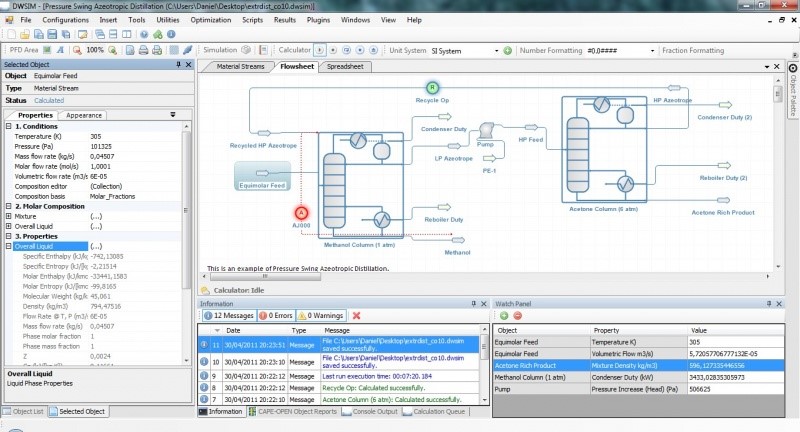Basic Process Simulation Course in DWSIM Software

About Course
Introduction on Process Simulation
Process simulation is used for the design, development, analysis, and optimization of technical processes such as: chemical plants, chemical processes, environmental systems, power stations, complex manufacturing operations, biological processes, and similar technical functions.
Process simulation is an important activity in process engineering covering the whole life cycle of a process, from research and development to conceptual design and plant operation.
Chemical process simulation aims to represent a process of chemical or physical transformation through a mathematic model that involves the calculation of mass and energy balances coupled with phase equilibrium and with transport and chemical kinetics equations. All this is made looking for the establishment (prediction) of the behavior of a process of known structure, in which some preliminary data of the equipment that compose the process are known.
Process simulation and optimization are of great importance for the design and operation of chemical manufacturing process as they can help improve productivity, performance and product quality in a reliable and economical manner.
The development of models for a better representation of real processes is the core of the further development of the simulation software. Model development is done on the chemical engineering side but also in control engineering and for the improvement of mathematical simulation techniques. Process simulation is therefore one of the few fields where scientists from chemistry, physics, computer science, mathematics, and several engineering fields work together.
A lot of efforts are made to develop new and improved models for the calculation of properties. This includes for example the description of
- Thermo physical properties like vapour pressures, viscosities, caloric data, etc. of pure components and mixtures
- Properties of different apparatuses like reactors, distillation columns, pumps, etc.
- Chemical reactions and kinetics
- Environmental and safety-related data
Two main different types of models can be distinguished:
- Rather simple equations and correlations where parameters are fitted to experimental data.
- Predictive methods where properties are estimated.
About DWSIM Software
DWSIM is able to simulate steady-state, vapor–liquid, vapor–liquid-liquid, solid–liquid and aqueous electrolyte equilibrium processes with the following Thermodynamic Models and Unit Operations:
- Thermodynamic models: CoolProp, Peng–Robinson equation of state, Peng–Robinson-Strÿjek-Vera (PRSV2), Soave–Redlich–Kwong, Lee-Kesler, Lee-Kesler-Plöcker, UNIFAC(-LL), Modified UNIFAC (Dortmund), Modified UNIFAC (NIST), UNIQUAC, NRTL, Chao-Seader, Grayson-Streed, Extended UNIQUAC, Raoult’s Law, IAPWS-IF97 Steam Tables, IAPWS-08 Seawater, Black-Oil and Sour Water;
- Unit operations: CAPE-OPEN Socket, Spreadsheet, Custom (IronPython Script), Mixer, Splitter, Separator, Pump, Compressor, Expander, Heater, Cooler, Valve, Pipe Segment, Shortcut Column, Heat exchanger, Reactors (Conversion, PFR, CSTR, Equilibrium and Gibbs), Distillation column, Simple, Refluxed and Reboiled Absorbers, Component Separator, Solids Separator, Continuous Cake Filter and Orifice plate;
- Utilities: Binary Data Regression, Phase Envelope, Natural Gas Hydrates, Pure Component Properties, True Critical Point, PSV Sizing, Vessel Sizing, Spreadsheet and Petroleum Cold Flow Properties;
- Tools: Hypothetical Component Generator, Bulk C7+/Distillation Curves Petroleum Characterization, Petroleum Assay Manager, Reactions Manager and Compound Creator;
- Process Analysis and Optimization: Sensitivity Analysis Utility, Multivariate Optimizer with bound constraints;
- Extras: Support for Runtime Python Scripts, Plugins and CAPE-OPEN Flowsheet Monitoring Objects.
Note:
We advise the candidate to use only the PC version of DWSIM software instead of mobile or tab version, some of the advanced features are not supported by mobile version.
Here is the Link for downloading DWSIM
For window based PCs, please download the DWSIM from the below link,
https://sourceforge.net/projects/dwsim/files/DWSIM/
For Apple mac book users, please download the DWSIM from the below link,
https://sourceforge.net/projects/dwsim/files/DWSIM/
Course Content
Creating a Proces Flow Sheet Using DWSIM Software
-
Creating a Process Flow Sheeting Using DWSIM Software
08:44 -
Simulation Result
